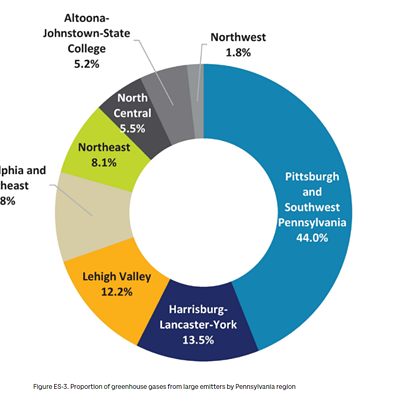Reports highlight how to repair the Appalachian economy without relying on fracking
[
{
"name": "Local Action Unit",
"component": "24929589",
"insertPoint": "3",
"requiredCountToDisplay": "1"
}
]
In the wake of the Great Recession, natural gas seemed like a viable foundation for economic recovery in Pennsylvania and the greater Appalachia region, which has abundant natural gas reserves. Companies such as Range Resources moved into the region promising job creation, but that broad economic recovery never really came for Appalachia’s large gas-producing areas.
Between 2008-2019, the 22 counties in Ohio, Pennsylvania, and West Virginia that produce 90% of Appalachian natural gas trailed the rest of the country in job growth, personal income, and population. Instead of the promised growth, a new report from the Ohio River Valley Institute shows how natural gas development led to economic distress and environmental hazards for those counties, which the report refers to as “Frackalachia.”
“It is a myth that we must make a decision between jobs and a healthy environment,” ORVI senior researcher and lead author of both reports Sean O’Leary said in a press release. “It’s simply not true.”
But ORVI doesn’t believe economic decline has to be Appalachia’s destiny. A companion report from the think tank offers a potential solution to Appalachia’s continued slump, and it delineates from the current strategy of relying on natural gas development.
The new report highlights the experiences of Centralia, Wash., a coal town that lost its coal mine and will soon lose its coal-fired power plant. Even with these setbacks — which are similar to things happening in Appalachian communities — Centralia has seen increases in its economy, jobs, and population; the rebound due to a $55 million economic and clean energy transition fund.
Titled “The Centralia Model for Economic Transition in Distressed Communities,” the report offers an alternative to continued reliance on the natural gas industry, which has slowed over the years. According to another ORVI report, income from leasing and royalties from fracking in Appalachia were less than expected due to the price of natural gas falling below 2010 projections. Estimates also show that less than 20% of leasing and royalty revenue entered local economies despite assumptions of 100% in initial economic impact studies. Pro-fracking groups like the Marcellus Shale Coalition have pushed back on ORVI’s reports, and dismissed them as the work of activists.
Although it is based on a Pacific Northwest coal town, the report notes the similarities in economic downturn, job loss, and population loss to “Frackalachia.”
But a main difference between Centralia and Appalachian towns is that Trans Atlanta, the owner of the coal-fired power plant, created the Centralia Coal Transition Fund, committing to distributing $55 million in grants to promote economic development and fund weatherization and clean energy technologies, including $1 million to electrify the freight terminal for the ports of Seattle and Tacoma. The Energy Technology Fund also funded public transportation electrification and a feasibility study for the development of a long-duration battery storage facility, which has the potential to make solar and wind energy more viable alternative energy sources.
Centralia also saw a rise in wages and personal income that exceeded the national average after the fund investment, and the economic growth was consistent with the grant program areas of focus, such as energy efficiency, which tended to be labor-intensive and was fulfilled by local workers. The grants also encouraged additional private investment, which compounded their impact, according to ORVI.
The report notes that, while the question remains as to where similar funding would come from in “Frackalachia,” the $55 million that the Centralia Coal Transition Board will disperse is a small amount of cash relative to the economic impact it’s had. The authors note that the private sector, especially natural gas companies, have a “moral if not yet a legal obligation to provide assistance,” but that other sources of funding could include the federal government’s transition funding, state governments’ tax reform, and participation in programs such as the Regional Greenhouse Gas Initiative, as well as private philanthropy.
“When economic stimulus is heavily oriented towards energy efficiency and education, the payoff is immediate,” O’Leary said.
Between 2008-2019, the 22 counties in Ohio, Pennsylvania, and West Virginia that produce 90% of Appalachian natural gas trailed the rest of the country in job growth, personal income, and population. Instead of the promised growth, a new report from the Ohio River Valley Institute shows how natural gas development led to economic distress and environmental hazards for those counties, which the report refers to as “Frackalachia.”
“It is a myth that we must make a decision between jobs and a healthy environment,” ORVI senior researcher and lead author of both reports Sean O’Leary said in a press release. “It’s simply not true.”
But ORVI doesn’t believe economic decline has to be Appalachia’s destiny. A companion report from the think tank offers a potential solution to Appalachia’s continued slump, and it delineates from the current strategy of relying on natural gas development.
The new report highlights the experiences of Centralia, Wash., a coal town that lost its coal mine and will soon lose its coal-fired power plant. Even with these setbacks — which are similar to things happening in Appalachian communities — Centralia has seen increases in its economy, jobs, and population; the rebound due to a $55 million economic and clean energy transition fund.
Titled “The Centralia Model for Economic Transition in Distressed Communities,” the report offers an alternative to continued reliance on the natural gas industry, which has slowed over the years. According to another ORVI report, income from leasing and royalties from fracking in Appalachia were less than expected due to the price of natural gas falling below 2010 projections. Estimates also show that less than 20% of leasing and royalty revenue entered local economies despite assumptions of 100% in initial economic impact studies. Pro-fracking groups like the Marcellus Shale Coalition have pushed back on ORVI’s reports, and dismissed them as the work of activists.
Although it is based on a Pacific Northwest coal town, the report notes the similarities in economic downturn, job loss, and population loss to “Frackalachia.”
But a main difference between Centralia and Appalachian towns is that Trans Atlanta, the owner of the coal-fired power plant, created the Centralia Coal Transition Fund, committing to distributing $55 million in grants to promote economic development and fund weatherization and clean energy technologies, including $1 million to electrify the freight terminal for the ports of Seattle and Tacoma. The Energy Technology Fund also funded public transportation electrification and a feasibility study for the development of a long-duration battery storage facility, which has the potential to make solar and wind energy more viable alternative energy sources.
Centralia also saw a rise in wages and personal income that exceeded the national average after the fund investment, and the economic growth was consistent with the grant program areas of focus, such as energy efficiency, which tended to be labor-intensive and was fulfilled by local workers. The grants also encouraged additional private investment, which compounded their impact, according to ORVI.
The report notes that, while the question remains as to where similar funding would come from in “Frackalachia,” the $55 million that the Centralia Coal Transition Board will disperse is a small amount of cash relative to the economic impact it’s had. The authors note that the private sector, especially natural gas companies, have a “moral if not yet a legal obligation to provide assistance,” but that other sources of funding could include the federal government’s transition funding, state governments’ tax reform, and participation in programs such as the Regional Greenhouse Gas Initiative, as well as private philanthropy.
“When economic stimulus is heavily oriented towards energy efficiency and education, the payoff is immediate,” O’Leary said.

















